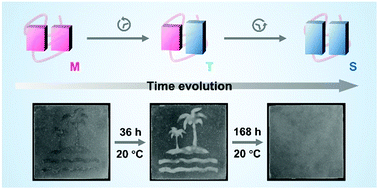Self-evolving materials based on metastable-to-stable crystal transition of a polymorphic polyolefin†
Abstract
Living organisms can self-evolve with time in order to adapt to the natural environment. Analogically, self-evolving materials also show similar properties based on non-equilibrium structural transformation. The common design of these materials tends to rely on solutions and hydrogels, yet only little attention has been paid to dry materials. To break this limitation, a new principle for developing self-evolving materials from a commercialized polymorphic polyolefin via programmable crystal transition is proposed. The self-evolving materials can encode information on patterns and morphing by the metastable crystal phase. Dynamically, this phase transforms to the stable crystal phase so that the encoded information self-evolves with time, displaying the autonomous characteristic. Moreover, this process can be interrupted at an arbitrary time through solvent-induced recrystallization. These advantages have been demonstrated by fabricating an edible period indicator and imitating sophisticated human body language. It is believed that this work may inspire future research studies on self-evolving materials based on the non-equilibrium process of dry materials.



 Please wait while we load your content...
Please wait while we load your content...